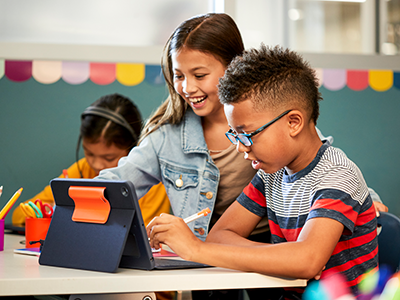Want Students to Get the Best From Technology? Improve the Learning Environment
Watch the Recording Listen to the Podcast
With all the learning benefits of EdTech, it’s surprising that almost 60% of students are less engaged in the classroom than they were with less technology. It seems technology has become too much of a good thing, reducing student energy and concentration during the school day.
Modifying the learning environment is necessary to maximize student tech-related focus and stamina. During the edLeader Panel, “Focus and Engage: How EdTech Hardware Can Boost Student Outcomes,” EdTech leaders described how to begin re-envisioning three aspects of classroom settings to enhance student interaction, engagement, and success with technology.
1. Adjusting the Physical Learning Environment
Data from the 2022 survey The Ergonomics Equation: Creating a More Comfortable Classroom, a joint Logitech and EdWeek Research Center project, revealed how technology affects learners’ physical comfort:
- 74% of educators indicated that students’ physical comfort while using EdTech has an impact on their level of learning engagement.
- 60% of students between 10 and 17 reported discomfort using laptops without the appropriate hardware tools.
- 28% of secondary school educators said their students experience neck, back, or wrist pain and fatigue while using EdTech.
There is the furniture that is not designed to accommodate technology, along with students straining their necks, trying to put on and adjust their headphones, and leaning down to find devices and other items, all among ergonomically challenging conditions that increase learner discomfort.
There are solutions to these impediments to enhance student well-being and overall learning engagement. They include:
Dynamic Seating Spots
Establish classroom sections with comfortable furniture and related items. One site, for example, might have tables, desks, and chairs. Another area might offer beanbags that calm students and reduce their jitters. Yet another might hold pliable cushions that serve as fidget toys to help students focus.
Headphones
Provide over-the-head headphones that learners tend to find comfortable. They are ideal for listening to videos, assignments, or music to stay calm and focused as they navigate longer lessons and tasks.
De-fronted Classrooms
De-fronting requires reconfiguring the classroom to invite student collaboration and engagement, shifting away from a teacher-led (stand and lecture) learning environment. The most significant change is moving the teacher’s desk from the front of the room. Instead, the teacher interacts with students from various classroom spots.
Standard student-facing rows have also become a thing of the past. Instead, desks are in a random configuration that invites student collaboration. Student groups might also stand to work together on tools like whiteboards. De-fronting ultimately creates a more comfortable, equitable, and non-passive learning environment.
Comfortable Tech
Provide technology with which students are comfortable and that they can easily use to propel their participation.
Declutter
Arrange technology to avoid cable clutter, which can come with multiple classroom devices. Consider ways for learners to share devices to reduce the number of obstructive wires, etc.
2. Removing Visual Barriers
The Logitech/EdWeek survey revealed that 42% of educators reported that students have trouble seeing images and other materials. Therefore, reducing visual obstacles is crucial for learner engagement and participation.
One approach is establishing open and dynamic learning environments. Teachers can create and maintain classrooms (space, equipment, materials, etc.) that promote student learning and rely on various technologies to meet students’ learning needs.
For example, one side of the room might be for technology, where students can use interactive panels or find Chromebooks and iPads. Literature for reading can be found in another section of the room.
Making sure students are seated in ways that height does not impede vision (like shorter students sitting behind taller students) is essential, easily addressed by dynamic seating and random configuration.
When using technology, ensure students are clear on the directions for accessing what they need for an activity. For instance, are instructions clear in Google Classroom or Schoology? And, use technology (like Pear Deck) that promotes collaboration through content that remains visible on screen. As learners interact with technology, teachers should move around the room to observe what they are doing and missing and identify what they can’t “see” (in terms of visual access and comprehension).
3. Reducing Noise Pollution
Classroom noise (along with external noise) can be as loud as 77 decibels—above the level the World Health Organization recommends for healthy hearing.
Students talking, machinery, devices, street traffic, and construction are among the conditions that contribute to noise pollution in the learning environment and affect learners’ ability to focus. In addition, over 75% of educators say they strain their voices because they have to talk above high volume for learners to hear them.
Some solutions stem classroom noise to benefit instruction and learning:
- Amplifying, usually with a microphone, to make sure students hear.
- Providing headphones (yes, back to those) enables students to plug into and listen to their devices.
- Calming students before class starts reduces tumult and noise. Deep breathing exercises help on this front, as does a chime or music, all soothing tools to which learners are receptive.
- Giving students wait time to answer a question, allowing them time to think and reflect, thus slowing down response time that cuts back on the “noise” from multiple responders. Another option is to have them respond digitally.
- Reminding students to pause and keep down the sound before they reconvene after collaborating in small groups.
- Setting up audio enhancement beams—systems that enhance the sound in the classroom.
Sometimes, it’s not about technology’s merits or deficits but about the ways and the space in which they are used. Enriching students’ EdTech experiences and overall engagement might start with a few classroom and instructional tweaks for a more comfortable and inviting learning environment.
Learn more about this edWeb broadcast, “Focus and Engage: How EdTech Hardware Can Boost Student Outcomes,” sponsored by Logitech.
Watch the Recording Listen to the Podcast
Join the Community
Technology in Schools is a free professional learning community where district administrators, school leaders, and all educators can share ideas, examples, and resources that relate to integrating technology effectively in schools.
For over 40 years, Logitech has been a global leader in connecting people through innovative computer peripherals. Now we’re a multi-brand company designing products that bring people together through video, audio, gaming, creating and more. We believe in the power of bringing best-in-class design to classroom tools to help both students and teachers achieve their very best. We do that by designing products for students and educators, with students and educators. We work with hundreds of students and teachers throughout our design process – from earliest concepts to prototype testing and final product input. Their feedback and insights unlock meaningful product choices.
Blog post by Michele Israel, based on this edLeader Panel






Comments are closed.